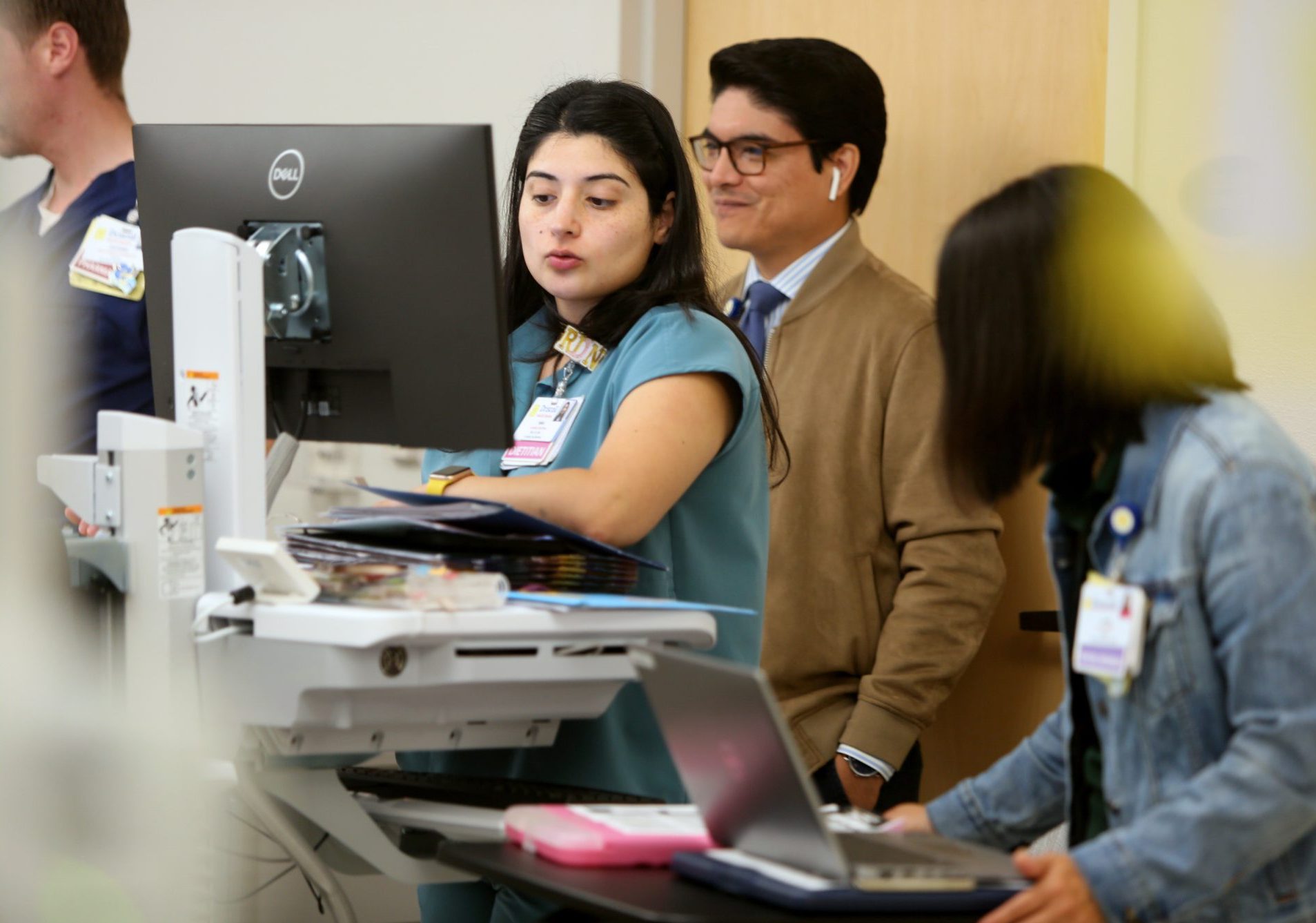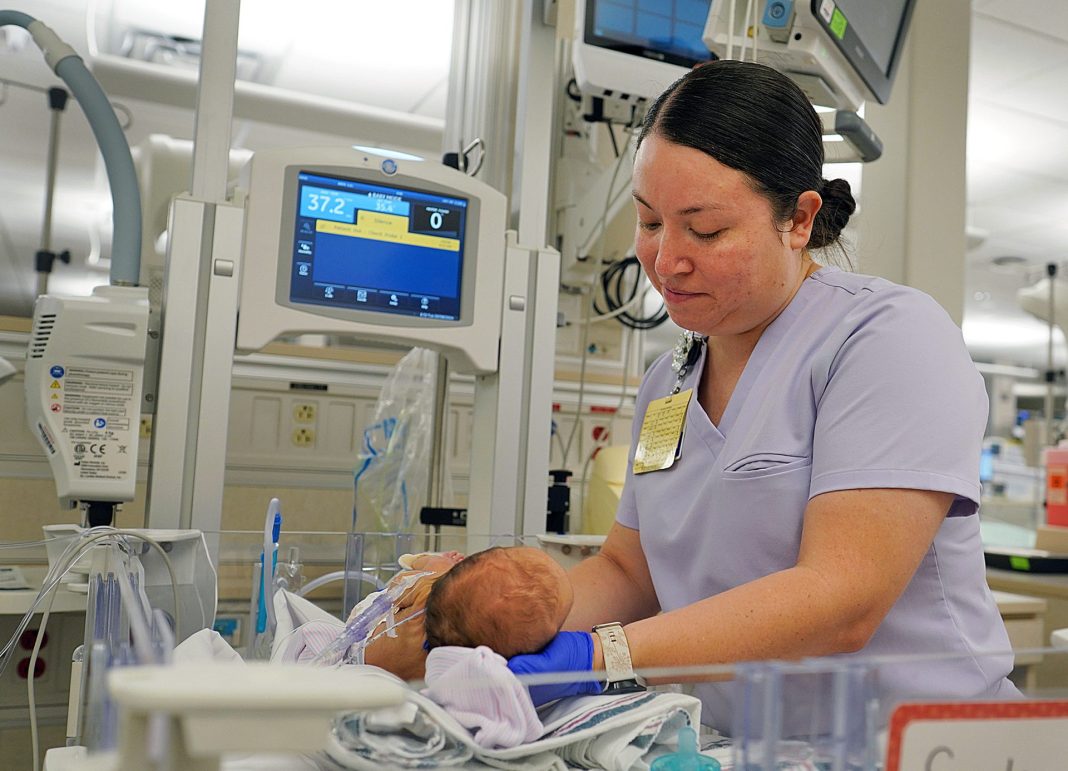|
Only have a minute? Listen instead
Getting your Trinity Audio player ready...
|
EDINBURG — The Centers for Disease Control and Prevention found that the preterm birth rate in Texas was 11.26% of all births in 2022, a slight decline from the previous year on record, but the second highest since the 2000s.
While there are many factors that can influence these statistics, it has roughly translated to about 1 in 10 babies being born prematurely in the state over the last decade.
The devoted medical staff who treat them can often be overwhelmed inside the neonatal intensive care units, where these newborns require ‘round the clock care in the most sterile conditions, especially if there is an upswing in premature births.
On Tuesday, the newly opened Driscoll Children’s Hospital Rio Grande Valley provided The Monitor with a tour of its NICU in Edinburg to get a better understanding of the conditions necessary to nurture these children to health and stability.
The tour, led by Driscoll’s Chief Nursing Officer Laura Meister, revealed how this Valley healthcare institution stands ready to breathe life into these vulnerable newborns.
“Our NICU is a level 3 nursery and we take care of extremely low birth weight babies,” she said, adding that they’ve cared for infants as young as 22 weeks old.
According to Meister, a level 3 unit is defined as a nursery that cares for “really sick babies” who may be very small, and who may have different anomalies or illnesses.
She added that in order to be considered a level 4 NICU they would have to be able to provide care such as extracorporeal membrane oxygenation, or ECMO.
Meister explained that the NICU staff, including neonatologist and nurse practitioners, ensure that the babies receive the necessary nourishment to help them continue to grow and get healthy.

She explained that although DHR Health previously had the same level NICU, the difference between the two is that Driscoll includes support services such as a mental health counselor, discharge coordinator, speech therapist, physical therapist and other support services for the families.
“That’s really some of the positive things that Driscoll is able to offer — … that full-service support of being a designated children’s hospital,” Meister said.
INSIDE THE NICU
Although there are various ways to enter the Driscoll’s NICU, the main entrance is located on the west side of DHR Health’s Women’s Hospital.
On that side there is a door with Driscoll’s logo leading to the NICU welcome center. At the entrance, like most hospitals and clinics, there is a seating area and check-in area.
As we made our way through the doors leading to the NICU, Meister explained that the unit is divided into two floors separated by acuity — the first floor for lower acuity and the second for higher acuity patients.
She explained that not only does the unit care for the babies after delivery but also has a high risk follow-up clinic dedicated to check-ups after a baby is discharged. The clinic is available to both former NICU patients as well as babies referred to them.
Walking down the hall and turning to the left there is the entrance to the first floor of the NICU with the elevators located on the left side.
As we stepped off the elevators, to the left is the entrance to the NICU’s second floor which is technically where the tour began. This floor is noticeably more active even by sound, as various beeps and bloops from medical machines can be heard throughout.
The first floor was much quieter by comparison.
But on this floor you’re instantly struck by the most delicate care required for many of the babies present, babies whose needs vary greatly.

For as fragile as they are, however, the staff appeared just as devoted to their purpose: to protect what is precious.
Immediately upon entering one could see three rows of neonatal bays to the right, beds made specifically for premature babies, connected to various machines such as a ventilator, intravenous therapy, or IV stands and other machines.
In the mornings a team of specialists conduct what Meister referred to as interdisciplinary rounds in which mental health specialists, pharmacists, dietitians, physicians and other specialists are updated on the conditions of each baby in the unit and the type of care they require.
The rounds also help physicians follow up with the families for updates.
The type of bay used in the NICU is called a Giraffe OmniBed Carestation made specifically to address the demands of neonatal intensive care through consistently controlled thermal environments as well as better patient access and visibility.
Although not every baby requires the regulation of temperature, each bay has the capability to do so.
The level of care a baby needs determines the equipment used. Near the entrance of the NICU was a baby who had a bili light that is used to treat newborn jaundice.

Meister added that they place “eye covers” on the baby to protect them from the light when using the bili light.
To the left of the bays is the nursing station with a second entrance located behind the station leading to another area of the NICU used to accommodate more bays.
In total the top floor has 35 beds including three private rooms located at the back of the room for the babies who are quarantined or require lower stimulation.
“We have some ability to double bunk babies,” Meister said, adding that this is often used for twins.
The NICU has a total of 63 beds with another 28 located on the first floor.
By each bay there are two chairs for the parents so they can visit their babies.
A couple stood near a bay as a nurse tended to their child, watching with softness in their eyes as they studied their newborn.
Some of the babies had blankets over their bays to protect them from overstimulation.
There is also a notable temperature shift upon entering the area as well, something Meister said is necessary to help the newborns stay warm. In fact, the temperature set in the NICU was 78 degrees that day.
On the side of the wall near the nursing station were three carts that include supplies to restock the bedside as well as any necessary tools for procedures that are often done at the bedside.

Other carts were scattered around the room as well near nurses who were tending to the babies.
This is where much of the activity ends, given that the first floor has open cribs for newborns who may have oxygen needs, feeding issues and whose blood sugar levels need to be monitored, and nursing ratios are slightly different as well since fewer are needed here.
“They don’t need as intensive monitoring,” Meister said.
Perhaps the most compelling sights were those of the children themselves, some of whom appeared no bigger than a football and needed help breathing, and the nurses who with the gentlest touches toiled over their care and saw to their every need.
In a facility where from week to week the number of newborns treated there can range between the 30s and 60s, there did not appear to be much time to waste as the medical staff present at Driscoll on this day juggled duties associated with the babies and the worried parents.
Editor’s note: This story was updated to clarify that Driscoll’s NICU is located inside DHR Health’s Women’s Hospital.




